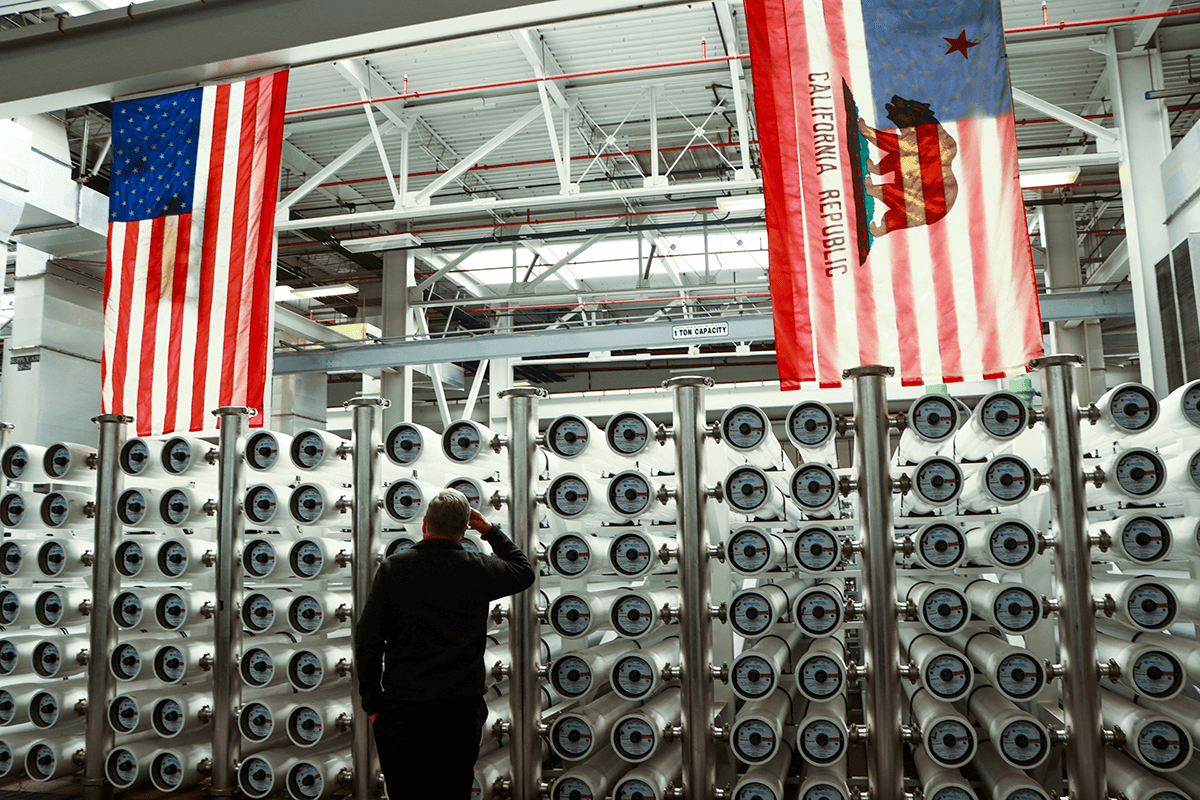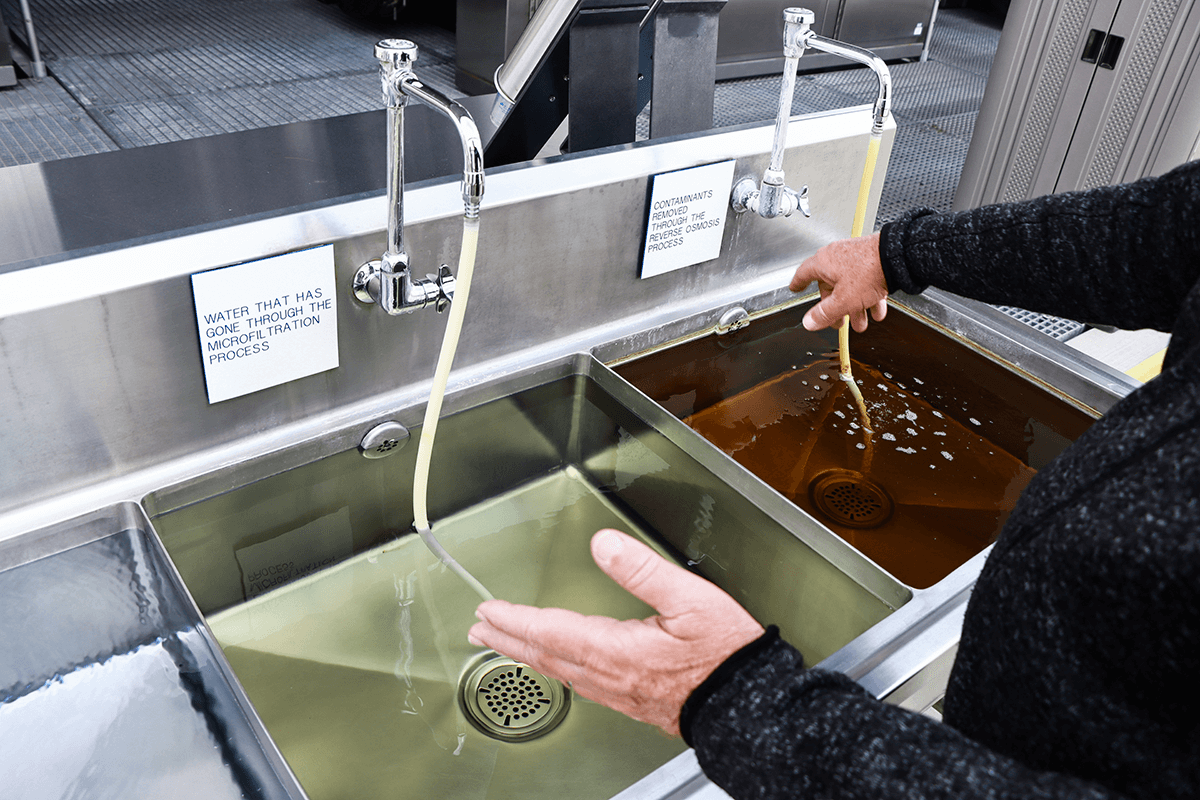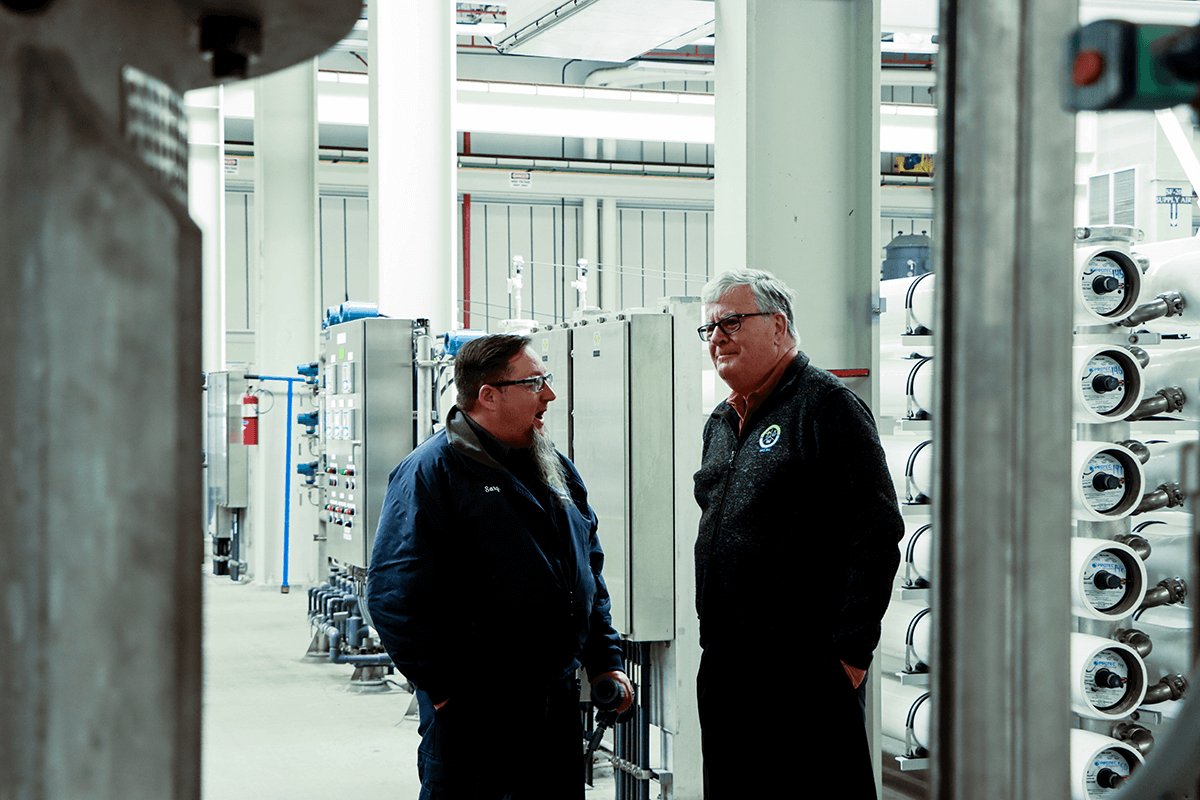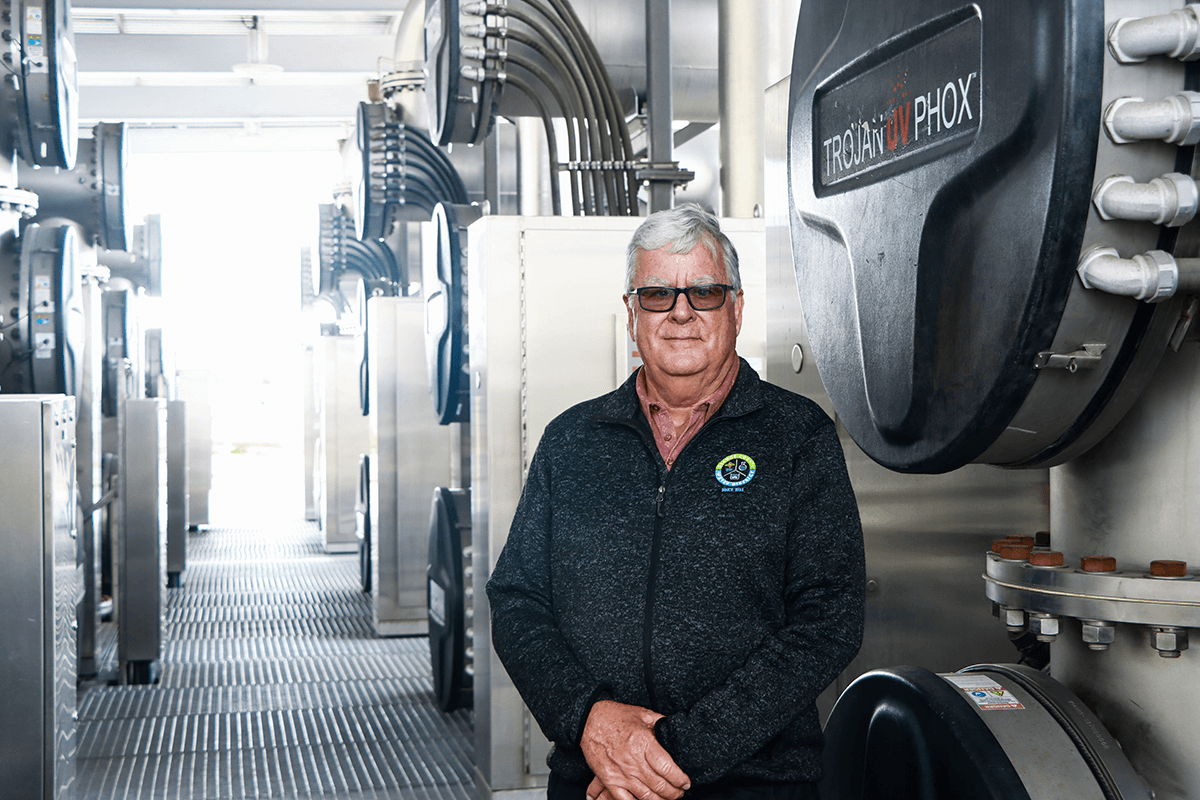Let It Flow: Building the World’s Largest Recycling Plant ― in Orange County
The future looked grim for the Orange County Water District, the agency responsible for managing the Orange County groundwater aquifer, the source of clean drinking water for 2.5 million residents in the northern and central parts of the county.
For decades, OCWD relied on groundwater as the main source of water for its customers. However, longer and more frequent droughts, a result of climate change, meant less rainwater to fill aquifers. By the 1980s, it became clear that the water district would have to dramatically increase its purchase of expensive imported water.
At the same time, the Orange County Sanitation District, OCWD’s partner agency, faced water challenges of its own. The sanitation district was responsible for treating wastewater and making it clean enough to discharge safely into the Pacific Ocean. However, the county’s surging population and water demand meant that the OC Sanitation District might have to build another expensive 5-mile pipeline to empty treated wastewater into the ocean. Environmentalists vehemently opposed the plan.
Going big and bold

What to do?
The Orange County Water District decided to go big and bold. In a place Ronald Reagan once said is where “good Republicans go before they die,” OCWD, in collaboration with the OC Sanitation District, opted to build the world’s largest wastewater recycling plant in the county. Doing so would ensure a reliable supply of drinking water and capture water from the OC Sanitation District that would otherwise flow into the Pacific.
OCWD officials felt confident in their decision. After all, the water district had a reputation as a pioneer and leader in the field of water recycling, having built, in 1975, the world’s first advanced water treatment plant using reverse osmosis to purify wastewater to near-distilled-water quality. The OC Water District also had an esteemed in-house research team that identified cutting-edge technologies and thoroughly tested them before deployment.
In January 2008, after about 10 years of planning and construction, the Orange County Water District opened the $481-million Groundwater Replenishment System, or GWRS, featuring the largest water recycling facility in the world. In 2015, the water purification project expanded by 30 million gallons per day and then by another 30 million in 2023. Today, GWRS can produce 130 million gallons of clean water from wastewater daily, enough to provide high-quality water for 1 million people in Orange County.
Overseeing the entire project ― which in 2009 received the American Society of Civil Engineers’ Outstanding Civil Engineering Achievement Award ― was USC Viterbi alumnus Michael Markus, M.S. CM ’92. The former general manager of OCWD helped to supervise the wastewater recycling project’s design, development, building and expansions. He also played an integral role in securing government funding.
Equally important, Markus ran a successful yearslong outreach campaign that won strong community backing, despite the widespread “ick factor” of transforming tap, toilet and bathwater into drinking water. Whereas Los Angeles, San Diego and the San Gabriel Valley had scuttled similar large-scale water recycling projects, “We didn’t really have any opposition,” Markus said. He believes his team prevailed where others had failed by making about 1,200 in-person presentations to service organizations, politicians and residents, among others, between 1997 and 2007, answering any and all questions thoroughly and transparently.
Mehul Patel, executive director of operations for the Orange County Water District, marvels at Markus’ stewardship of the Groundwater Replenishment Project, first as construction manager and later as OCWD general manager.
“He had the vision to see a problem, work collaboratively to find solutions, bring two agencies together, and develop the biggest and first [wastewater recycling system] that’s now being copied and implemented in other parts of California and even other parts of the U.S., Texas, Florida and Arizona,” Patel said.
Said Markus, who retired from the Orange County Water District in 2024 after 35 years of service: “It still kind of blows my mind that we’ve been operating the facility for 17 years now, a tremendous amount of time, and others are still trying to catch up.”
The Groundwater Replenishment System in action

As a first step, the OC Sanitation District treats wastewater at plants in Fountain Valley and Huntington Beach. Instead of sending the treated wastewater into the ocean as it once did, the sanitation district delivers it to the Groundwater Replenishment System in Fountain Valley, where microfiltration, reverse osmosis, and ultraviolet light with hydrogen peroxide purify the treated wastewater.
At that point, most of the water travels through a 14-mile pipeline to Anaheim, where it replenishes the groundwater aquifer and undergoes natural filtration. After six months or so underground, the clean water is ready to flow through faucets.
About 40 million of the 130 gallons produced daily by GWRS are pumped into so-called injection walls in Huntington Beach, Fountain Valley, Santa Ana and elsewhere in Orange County to create barriers that prevent saltwater from contaminating freshwater.
A triumph of civil engineering ingenuity and one of the most celebrated water reuse projects in the world, the Groundwater Replenishment System has won more than 80 awards since its opening in 2008. Accolades include the 2008 Stockholm Industry Water Award, 2014 U.S. Water Prize and the 2014 Lee Kuan Yew Water Prize. Five years later, in 2019, GWRS set the Guinness World Record for the most wastewater recycled into drinking water (100 million gallons) in a 24-hour period.
Markus’ oversight, leadership, political savvy, smarts and tenacity helped make the Groundwater Replenishment System a reality. In recognition of his many professional contributions, Markus received the USC Sonny Astani Department of Civil and Environmental Engineering 2023 Lifetime Achievement Award.
Additionally, he was named the 2017 Pioneer in Groundwater by the Environmental & Water Resources Institute, selected as one of the Top 25 Industry Leaders of 2014 by Water & Wastewater International, and received the 2007 American Society of Civil Engineers’ Government Engineer of the Year award.
“For more than three decades, Mike worked at the Orange County Water District, building and delivering projects that are known ― and have been emulated ― around the world,” said Amy Childress, Dean’s Professor of Civil and Environmental Engineering and director of the USC ReWater Center. Childress worked alongside Markus at OCWD in 1994.
‘He’s a superstar’

If Markus had retired after the completion of the first phase of the Groundwater Replenishment System, his legacy as an innovator in water management would have been secure. But his commitment to ensure a steady and safe supply of water to the 19 Orange County cities that rely on the Orange County Water District, including Fullerton, Santa Ana and Fountain Valley, propelled him forward.
Years later under his leadership, the Orange County Water District began removing PFAS, also known as forever chemicals, from the local water supply in the most ambitious and far-reaching program of its type in California and possibly the nation, OCWD’s Patel said. The water agency, in expectation that the Environmental Protection Agency would mandate federal standards requiring no more than 4 parts of PFAS per trillion, “got in front of the issue,” Markus said. At the time, some OCWD cities posted levels between 10 to 15 parts per trillion, he added.
In 2022, the water district began installing high-tech treatment systems on the impacted wells from which municipal customers draw their water. To date, OCWD has treated about 60 of the 100 wells in need of remediation, protecting the public’s health by reducing the cancer-causing chemical to trace levels.
“[Markus] is a superstar,” USC Viterbi’s Childress said.
A problem solver

Growing up, Markus said he “liked to solve problems” and decided to become an engineer, a career that would allow him to do just that. In 1978, he earned a B.S. degree in civil engineering at Cal Poly Pomona. At the time, Markus had no idea that water would become the centerpiece of his professional life.
“I kind of stumbled into it,” he said with a laugh.
After graduating from college, he worked for a decade as a general contractor. With the Clean Water Act’s passage just a few years earlier, he helped build several wastewater treatment plants to help cities comply with the new federal water regulations.
In 1988, Markus joined the Orange County Water District’s construction division. He performed so well that he eventually oversaw the building of the renowned Groundwater Replenishment System, an incredibly complex undertaking that featured seven individual projects. In 2007, Markus was named as the water district’s sixth general manager, a position he held until his retirement in early 2024.
His career success notwithstanding, Markus, now 69, said he considers earning a USC Viterbi master’s degree in construction management in 1992 among his biggest achievements. Markus had long promised himself that he would one day go to USC and earn a graduate degree. However, work, family and life intervened.
So when he matriculated at Troy in 1990, Markus came with a strong professional background and boundless enthusiasm. He credits his time at USC with equipping him with the skills needed to flourish as GM at the Orange County Water District.
“The engineering and business courses I took gave me a much broader understanding of construction engineering,” Markus said. “So I was able to take that broader information and utilize it in the experiences that I had moving forward. It was a fantastic experience.”
Unsurprisingly, Markus was a fantastic student. So good, in fact, that Henry “Hank” Koffman, director of the Construction Management Program for 33 years, asked him to become an adjunct professor after he graduated.
Markus taught for two years and loved it. However, he said his increased responsibilities at the Orange County Water District reluctantly led him to give it up.
“He was an excellent teacher: dedicated, hardworking, a good communicator and really smart,” Koffman said. “And he later made a great contribution to our society in executing and making [the Groundwater Replenishment System] work. I’m very proud of him.”
These days, Markus consults with cities about wastewater recycling projects as co-founder of Pure Water Consulting Engineers. He also enjoys traveling with his wife and playing golf.
Looking back, he feels nothing but gratitude.
“You know, I’ve really been kind of blessed, career-wise, being in the right place at the right time and being involved with such a groundbreaking project, the Groundwater Replenishment System,” he said. “It’s been quite a run.”




